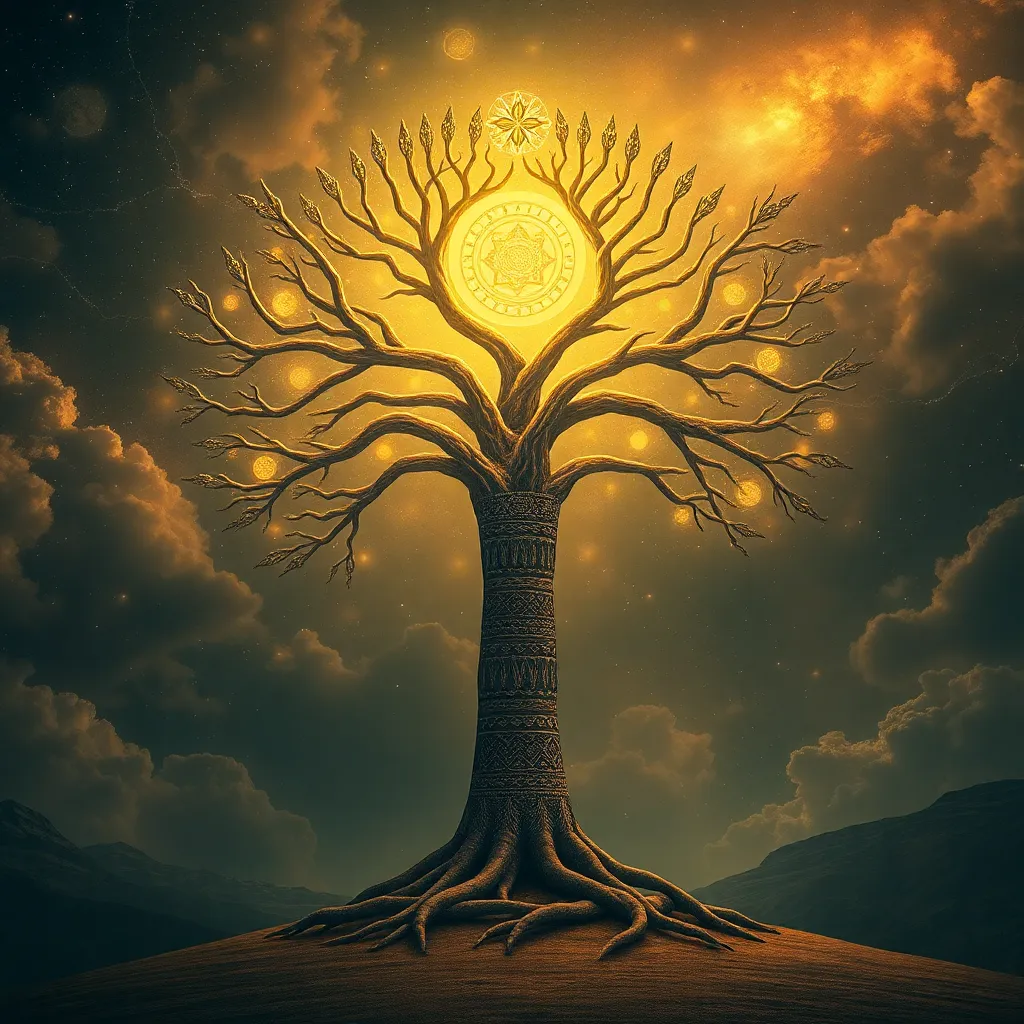The Cosmic Tree: Symbolism in Egyptian Mythology
I. Introduction
The Cosmic Tree, often regarded as a profound symbol in various mythologies, represents the interconnectedness of life, the universe, and the divine. In Egyptian mythology, this concept is intricately woven into the fabric of their beliefs, reflecting the ancient Egyptians’ views on existence and the cosmos.
Trees have held significant importance in ancient cultures around the world, symbolizing life, growth, and sustenance. They are often seen as sacred beings that bridge the material and spiritual worlds. This article delves into the Cosmic Tree’s symbolism within Egyptian mythology, exploring its multifaceted roles and connections to various deities, artistic representations, and its resonance with other cultural narratives.
II. The Concept of the Cosmic Tree in Egyptian Mythology
The Cosmic Tree in Egyptian mythology can be described as a mythical entity that embodies the essence of creation and the universe. It is often associated with various species of trees, including the sycamore and acacia, which held particular significance in their religious practices.
In the Egyptian creation myth, the Cosmic Tree plays a pivotal role. Some myths suggest that the tree stood at the center of the universe, connecting the heavens and the earth. It is believed that from this tree sprang forth life, including the gods themselves, symbolizing the genesis of all existence.
This tree is not just a physical entity but a representation of the universe’s structure, embodying the cyclical nature of creation, preservation, and destruction. It serves as a reminder of the delicate balance within the cosmos, illustrating how all elements are interlinked.
III. The Tree of Life: Its Significance
The Tree of Life within Egyptian mythology is a powerful symbol that represents the cycles of life, death, and rebirth. It signifies the journey of the soul and the perpetual renewal of existence.
- Representation of Life, Death, and Rebirth: The Tree of Life embodies the continuous cycle of life. Just as trees shed their leaves and grow anew, so too do souls undergo transformation.
- Symbolism of Nourishment and Sustenance: Trees provide food and shelter, representing the nurturing aspects of nature. In this context, the Cosmic Tree symbolizes the sustenance provided by the gods to humanity.
- Connection to the Afterlife and the Duat: The Duat, or the Egyptian underworld, is often depicted as a realm where the Tree of Life exists, providing sustenance for the deceased as they navigate their journey in the afterlife.
IV. Deities Associated with the Cosmic Tree
Several deities in Egyptian mythology are intricately connected to the Cosmic Tree, each representing different aspects of fertility, agriculture, and nurturing.
- Osiris: As the god of fertility and agriculture, Osiris is deeply associated with the life-giving properties of the tree. His mythology emphasizes the cycle of planting and harvesting, closely tied to the rhythms of nature.
- Isis: The nurturing goddess, Isis embodies the protective and sustaining aspects of the Cosmic Tree. She is often depicted as a mother figure, symbolizing the nurturing qualities of nature.
- Other Deities: Other gods and goddesses, such as Hathor and Set, also share connections with tree symbolism, representing various aspects of nature’s power and influence.
V. The Cosmic Tree in Egyptian Art and Architecture
The significance of the Cosmic Tree extends into the realm of art and architecture, where it is depicted in various forms and settings.
- Depictions in Temple Reliefs and Hieroglyphs: The Cosmic Tree is often illustrated in temple carvings and hieroglyphs, symbolizing divine connection and the sustenance provided by the gods.
- Influence on Tombs and Burial Practices: The presence of tree imagery in tombs highlights the belief in the afterlife. The tree serves as a symbol of resurrection and eternal life for the deceased.
- Symbolism in Artifacts and Sculptures: Various artifacts, including amulets and statues, often depict trees or tree-like motifs, emphasizing their spiritual significance in daily life and rituals.
VI. Comparisons with Other Cultures’ Cosmic Trees
The concept of the Cosmic Tree is not unique to Egyptian mythology; it resonates across various cultures, showcasing a universal archetype.
- Similarities with Mesopotamian Mythology: The Mesopotamian tree of life shares thematic elements with the Egyptian Cosmic Tree, symbolizing fertility and the connection between heaven and earth.
- Connections to the Norse Yggdrasil and Other Traditions: Yggdrasil, the Norse tree of life, serves a similar purpose as a cosmic connector, embodying the universe’s structure and interrelationships.
- The Universal Archetype of the Cosmic Tree: Across cultures, the Cosmic Tree remains a powerful symbol of life, interconnectedness, and the cyclical nature of existence.
VII. Modern Interpretations and Relevance
The symbolism of the Cosmic Tree continues to influence contemporary spirituality and art, reflecting its enduring legacy.
- Influence on Contemporary Spirituality and Environmentalism: The Cosmic Tree is often invoked in discussions surrounding nature conservation, symbolizing the interconnectedness of all living beings.
- The Cosmic Tree in Modern Literature and Art: Many contemporary authors and artists draw inspiration from the Cosmic Tree, exploring themes of growth, life cycles, and the environment.
- Continued Fascination with Ancient Symbols in Today’s Society: The Cosmic Tree remains a potent symbol, inviting exploration into ancient wisdom and its relevance in modern life.
VIII. Conclusion
The Cosmic Tree holds significant importance in Egyptian mythology, symbolizing the interconnectedness of life, creation, and the divine. Its representation in art, mythology, and religious practices illustrates the profound respect that ancient Egyptians had for nature and the universe.
As we reflect on the enduring legacy of the Cosmic Tree, we are reminded of the importance of exploring ancient symbols and their meanings in our contemporary world. The Cosmic Tree serves as a bridge between the past and the present, inviting us to consider our own connections to the earth and the cosmos.




